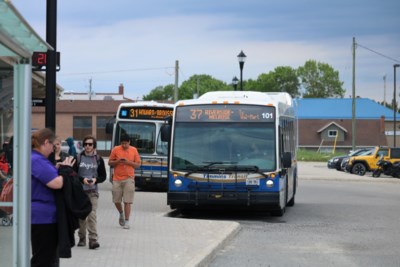Timmins Transit transports thousands and thousands of passengers around the city each year, and usually without incident. But if there is an issue, transit officials want the public to know the best course of action.
"They can either report it here, we have a complaint form they can fill out. Or send us an e-mail. We need details though. We need details of time, what bus, what route, what happened. Once this has all been filled out, we begin our investigation," said Catherine Verreault, Manager of Transit Services.
She said an investigation usually includes talking to the driver, and reviewing the video from the on-board cameras.
"That really helps us determine what actually happened."
Verreault made it clear that Timmins Transit does not monitor social media and web forums, and therefore posting a transit issue online is not the best course of action. The organization doesn't react unless an official complaint is received, but she said every official complaint is investigated. Either a form or an e-mail.
"Sometimes they'll call us, and they choose to remain anonymous. It's okay to be anonymous, but we need to be speaking to someone, or get something formal," said Verreault.
"If we get a phone call from somebody who wishes to remain anonymous, we'll fill out all the information, and put 'anonymous'. The unfortunate part is, sometimes if the person can't give me a bus number, a route number, a time, something, there's not much we can do. It's unfortunate, because our intention is to try to make it better for everybody. If I can't figure out who the person was, how can I solve the problem?" said Jamie Millions, Operations Supervisor for Timmins Transit.
He said the forms, if filled out properly, work the best at resolving an issue. He emphasized that a complaint is confidential, and that only he and Verreault will read them.
Verrault said that she understands some people prefer to 'vent' on social media, but urged people to take the proper steps if they hope for a resolution.
"We prefer to get to the bottom of it. We investigate. We take action on any valid complaint. We say 'valid' because some complaints don't turn out exactly as they were reported. We're fortunate, we have camera, and we have voice. So we can often hear the transactions that are happening. But we take action on any valid complaint. Anyone I've spoken to personally, I tell them 'we're going to take steps to correct this, and if it happens again, please let me know'. Because if you don't let me know, I think its corrected. That being said, if we were to, let's say take corrective action towards an employee, the complainant will never know the outcome of what we've done, because that would not be right either," she said, adding that she takes her job very seriously as the transit department's number one priority is to 'do the best we can for the public.'
"The majority of our employees here are in the same boat. They all just want to do a good job," she said.
The Timmins Transit video camera system, which is operational on all 19 conventional buses, and all six Handy Transit buses, has been in place for approximately three years.
"They've been a godsend. For many reasons," said Verreault.
The cameras play a huge role during the investigation process of an incident of complaint. She said they have worked in favour of both sides.
"Sometimes they help our drivers out, because it's pretty black and white what has happened. And sometimes definitely, there's no more 'he said-she said."
An issue that all communities with transit have experienced is passengers sent flying when a bus takes off before everyone is seated. Timmins Transit said extra caution is taken in this regard.
 Passengers wait at the Spruce Street Station. Andrew Autio for TimminsToday
Passengers wait at the Spruce Street Station. Andrew Autio for TimminsToday"We ask our drivers to wait. They're supposed to wait. It has happened. We have seen actually, where people are seated, and then they get up to go do something, and the driver thinks they're seated. But our drivers are asked to wait, if there is room to sit on the bus. If by chance the bus is full, there will be standing passengers. Our drivers are all very aware of different demographics of people who we transport. For an example an elderly person, who may take a little longer to sit down. But most of our drivers are very aware of that, and do their best. That's not something we hear a lot of. We do it hear it, but its a rare comment," said Verreault.
Millions said another occurrence is people ignoring the 'priority seating' protocol, which is often left to judgment.
"At times the driver might have to ask that a seat goes to a person with a mobility aid," he said.
The seats closest to the front of each bus are designated for people with mobility aids, walkers, canes, and wheelchairs. Next priority goes to senior citizens, and then mothers and strollers. These seats are fine to sit in when they are not in need, but riders should be prepared to give up their seat.
"The drivers don't manage it, but sometimes they have no choice. We have had people get upset with that," said Verreault.
"Overall our drivers are good. Unfortunately with complaints, we're going to address them, but if its the only thing that people are hearing about, they aren't hearing about the good stuff."
